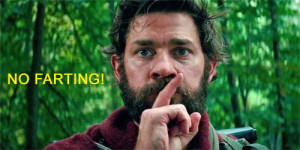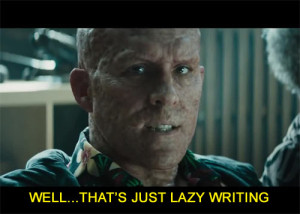 On a Facebook post, I said that “If you’re a fan of this movie and a parent, I pity your children.” I wrote that unapologetically; the intent was to be provocative and offensive. Just five minutes into this movie, I was stunned by a plot that relied on parents doing the equivalent of letting their toddler play on the freeway. Even more so, dismayed by the love slathered on this hot-mess of a movie. After moving beyond the “all people are stupid” rants, I started to examine why a blatantly terrible movie can be perceived as good.
On a Facebook post, I said that “If you’re a fan of this movie and a parent, I pity your children.” I wrote that unapologetically; the intent was to be provocative and offensive. Just five minutes into this movie, I was stunned by a plot that relied on parents doing the equivalent of letting their toddler play on the freeway. Even more so, dismayed by the love slathered on this hot-mess of a movie. After moving beyond the “all people are stupid” rants, I started to examine why a blatantly terrible movie can be perceived as good.
The premise of The Quiet Place is that Earth has been invaded by blind, vicious aliens that hunt using ultra-sensitive hearing. The few surviving humans stay alive by being as quiet as possible; even the tiniest noise can invite attack. According to the newspaper articles collected by the movie’s patriarch and pasted conveniently on the wall in his lair of useless technology, the aliens are indestructible and don’t eat what they kill. (Which begs the question: What do they eat?)
The movie opens in a small country store. A family of five–Mom, Dad, Teen Girl, Tween Boy, and four-year-old boy who shall be hereafter referred to a Monster Meal (M&M)–are wandering aimlessly about the shop. Mom is carefully, quietly taking a bottle off the shelf, and then giving meds to Tween Boy. Dad and Teen Girl are looking at stuff and no one is minding M&M who is literally running around the store. He’s barefoot, which apparently renders him totally soundless. (Bare feet tend to slap and make sticking sounds on many surfaces, but this movie spurns all logic.)
Note: We have a four-year-old child wandering about, unsupervised, in a world where the teeniest sound will attract lethal, human-seeking aliens.
The family starts to leave and the parents finally take notice of their youngest, just in time to see that he has monkey-climbed rickety shelving and is reaching for space shuttle toy. He knocks the toy to the floor, it hits with a loud crash, and aliens rush in and shred the entire family!
If only…
No, instead, Teen Girl manages to grab the toy before it hits the floor, saving the day (a feat that the poor child never gets any credit for). Dad finally does some parenting (Mom stands there, useless, thumb up her butt) and takes the toy away. For some reason, he removes the toy’s batteries. Not because he’s going to give it back, but because the writers needed an easy way to foreshadow doom.
Dad sets the toy and batteries on a nearby table, turns, and along with Mom and Tween Boy, leaves the shop without a backward glance. Teen Girl takes pity on her little bro, and hands him the toy, absent batteries, and then she too, leaves without checking to see if he is following.
Monster Meal stands alone for a while and then takes the batteries and finally follows the family. End scene.
Next scene. The family is walking through the woods. Mom and Dad are waaaay in front with their progeny trailing behind. Guess who’s bring up the rear, at least 30-ft behind? Monster Meal! It’s like they’re literally using the kid to troll for monsters.
Monster Meal has managed to correctly install the batteries in the toy; he pauses to switch it on and begins playing. The toy beeps and chirps, the siren song of slavering aliens, and Mom and Dad finally glance back at their child. Horrified, Dad runs back toward the child. Mom stands with her thumb up her butt (her Modus Operandi in the entire film). But alas, Dad is too far away. Stranger Thing‘s monster races out of the woods, kills M&M and runs off with his body. (If they don’t eat what they kill, why take the body?)
In summary, in a world where most of the population has been wiped out by unstoppable aliens who hunt via sound, Mom and Dad leave their youngest to wander alone, out of sight and out of easy reach, in alien-infested woods. Even though young children are pathologically inclined to self-destruction and this one demonstrated that tendency minutes before.
The first five minutes should break the movie for anyone with a functioning brain stem and certainly any responsible parent. It’s impossible for any logical human with a pinch of good sense to care about these people. Pity the children, yes; but the parents should be spayed/neutered before they breed more. (Alas, there are no veterinarians, and Mom is knocked up nine-months later because the screenwriters lacked imagination to develop a less cliched way to introduce drama into the plot.)
What follows is plot with more holes than a colander; the kind of story where logic gives up and cowers in a corner, weeping. My focus, however, is on the crucial first sequence, because, as a genre film/book fan, I typically suspend tons of disbelief on the weakest foundations for the sake of just enjoying fiction. What’s troubling is the ease with which many parents accept idiot Mom and Dad’s decision to let their child out of sight in a dangerous place.
I’ve seen arguments claiming the parents were watching, or that this kind of parenting takes place in real life. Putting aside jokes about mothers having eyes in the back of their heads, these parents clearly didn’t have eyes on Monster Meal. Else they would have notice he carried the banned toy. And the situation wasn’t real life, but instead one where a sneeze can get the entire family slaughtered in seconds. This isn’t a matter of parental nuance: how to raise a willful child vs. a sensitive child. It’s a safety issue on par with “Don’t leave your child in a hot car.”
So how are audiences, particularly parents with at least an thimble-full of common sense, ignoring the terrible parenting in The Quiet Place? My guess is that humans, all humans, self included, are not logical creatures, but unfortunately driven by emotion.
For example, Star Trek. In the usual canon, Spock’s reliance on scientific fact and logic is subtly portrayed as a flaw against Kirk’s emotion-driven “Let’s blow shit up” heroics. I confess, when the two men clash, I side with Kirk, because his viewpoint feels right. On closer examination, however, Spock’s “The needs of the many outweigh the needs of the few” approach is superior and would save lives and money. How many Enterprises has Kirk destroyed and what’s the price tag for a starship?
John Krasinski and Emily Blunt, despite the appalling context, deliver good performances. (Or at least Krasinski does; Blunt mostly looks constipated.) And Krasinski benefits from residual good will from his role as loveable Jim in The Office. People want to like him and his movie, they are charmed by the notion of a real life husband and wife on screen, and overlook The Quiet Place‘s legion of sins against logic.
The problem is that The Quiet Place‘s parents aren’t simply behaving illogically (in the first scene), but with criminal stupidity. So audiences preference for emotion over logic does not entirely explain the movie’s appeal.
Which leaves a final possibility: the movie’s venue. Early reviews from people viewing in theaters with large audiences were the most positive. Perhaps seeing the movie for the first time in a dark setting, and feeding off the collective fearful energy of other humans, an instinctive response, made it easier to ignore plot holes? Later reviews, including mine, come from those watching in the comfort of their living rooms, usually brighter settings with just few companions. Settings where one can say, “What the fuck was that?” and immediately point of flaws.
Ultimately, I still remain flummoxed by The Quiet Place‘s popularity, especially since, it’s essentially a story of family and parenting. No parent does everything right, but animals like elephants, dolphins, whales, chimpanzees, monkeys, and even musk oxen travel with the youngest within the group with adult bodies protecting the weakest. A movie that relies on generating sympathy toward the protagonists’ parenting should endow the parents with the basic good sense possessed by shit-flinging monkeys. In that respect alone, The Quiet Place is a huge fail.



